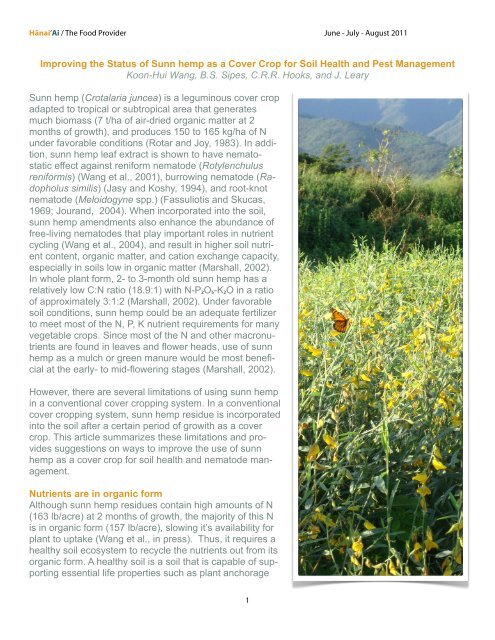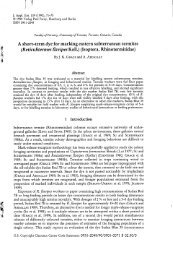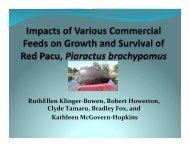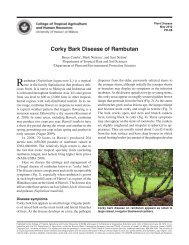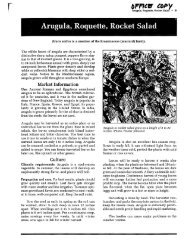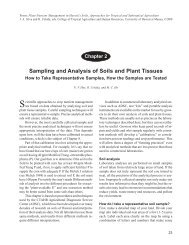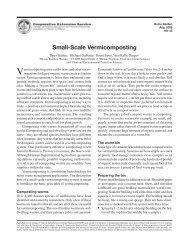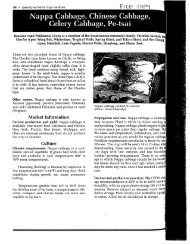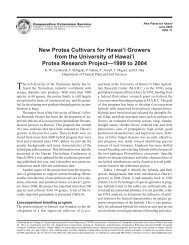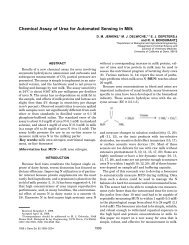Improving the Status of Sunn hemp as a Cover Crop for Soil Health ...
Improving the Status of Sunn hemp as a Cover Crop for Soil Health ...
Improving the Status of Sunn hemp as a Cover Crop for Soil Health ...
Create successful ePaper yourself
Turn your PDF publications into a flip-book with our unique Google optimized e-Paper software.
Hānai‘Ai / The Food Provider June - July - August 2011<br />
<strong>Improving</strong> <strong>the</strong> <strong>Status</strong> <strong>of</strong> <strong>Sunn</strong> <strong>hemp</strong> <strong>as</strong> a <strong>Cover</strong> <strong>Crop</strong> <strong>for</strong> <strong>Soil</strong> <strong>Health</strong> and Pest Management<br />
Koon-Hui Wang, B.S. Sipes, C.R.R. Hooks, and J. Leary<br />
<strong>Sunn</strong> <strong>hemp</strong> (Crotalaria juncea) is a leguminous cover crop<br />
adapted to tropical or subtropical area that generates<br />
much biom<strong>as</strong>s (7 t/ha <strong>of</strong> air-dried organic matter at 2<br />
months <strong>of</strong> growth), and produces 150 to 165 kg/ha <strong>of</strong> N<br />
under favorable conditions (Rotar and Joy, 1983). In addition,<br />
sunn <strong>hemp</strong> leaf extract is shown to have nematostatic<br />
effect against reni<strong>for</strong>m nematode (Rotylenchulus<br />
reni<strong>for</strong>mis) (Wang et al., 2001), burrowing nematode (Radopholus<br />
similis) (J<strong>as</strong>y and Koshy, 1994), and root-knot<br />
nematode (Meloidogyne spp.) (F<strong>as</strong>suliotis and Skuc<strong>as</strong>,<br />
1969; Jourand, 2004). When incorporated into <strong>the</strong> soil,<br />
sunn <strong>hemp</strong> amendments also enhance <strong>the</strong> abundance <strong>of</strong><br />
free-living nematodes that play important roles in nutrient<br />
cycling (Wang et al., 2004), and result in higher soil nutrient<br />
content, organic matter, and cation exchange capacity,<br />
especially in soils low in organic matter (Marshall, 2002).<br />
In whole plant <strong>for</strong>m, 2- to 3-month old sunn <strong>hemp</strong> h<strong>as</strong> a<br />
relatively low C:N ratio (18.9:1) with N-P2O5-K2O in a ratio<br />
<strong>of</strong> approximately 3:1:2 (Marshall, 2002). Under favorable<br />
soil conditions, sunn <strong>hemp</strong> could be an adequate fertilizer<br />
to meet most <strong>of</strong> <strong>the</strong> N, P, K nutrient requirements <strong>for</strong> many<br />
vegetable crops. Since most <strong>of</strong> <strong>the</strong> N and o<strong>the</strong>r macronutrients<br />
are found in leaves and flower heads, use <strong>of</strong> sunn<br />
<strong>hemp</strong> <strong>as</strong> a mulch or green manure would be most beneficial<br />
at <strong>the</strong> early- to mid-flowering stages (Marshall, 2002).<br />
However, <strong>the</strong>re are several limitations <strong>of</strong> using sunn <strong>hemp</strong><br />
in a conventional cover cropping system. In a conventional<br />
cover cropping system, sunn <strong>hemp</strong> residue is incorporated<br />
into <strong>the</strong> soil after a certain period <strong>of</strong> growith <strong>as</strong> a cover<br />
crop. This article summarizes <strong>the</strong>se limitations and provides<br />
suggestions on ways to improve <strong>the</strong> use <strong>of</strong> sunn<br />
<strong>hemp</strong> <strong>as</strong> a cover crop <strong>for</strong> soil health and nematode management.<br />
Nutrients are in organic <strong>for</strong>m<br />
Although sunn <strong>hemp</strong> residues contain high amounts <strong>of</strong> N<br />
(163 lb/acre) at 2 months <strong>of</strong> growth, <strong>the</strong> majority <strong>of</strong> this N<br />
is in organic <strong>for</strong>m (157 lb/acre), slowing it’s availability <strong>for</strong><br />
plant to uptake (Wang et al., in press). Thus, it requires a<br />
healthy soil ecosystem to recycle <strong>the</strong> nutrients out from its<br />
organic <strong>for</strong>m. A healthy soil is a soil that is capable <strong>of</strong> supporting<br />
essential life properties such <strong>as</strong> plant anchorage<br />
1
Hānai‘Ai / The Food Provider June - July - August 2011<br />
and nutrient cycling, chemical and physical soil processes, soil biodiversity, and even pest suppression.<br />
Under poor soil health condition (e.g. soil that had been fallow <strong>for</strong> some time), amending soil<br />
with sunn <strong>hemp</strong> might result in a nutrient starvation condition <strong>as</strong> bacteria and fungi only rele<strong>as</strong>e (mineralize)<br />
a small portion <strong>of</strong> nitrogen (N) into <strong>the</strong> soil while immobilizing most N in microbial biom<strong>as</strong>s.<br />
Thus, crops grown after a first cycle <strong>of</strong> sunn <strong>hemp</strong> cover cropping might seem nutrient deficient.<br />
However, <strong>the</strong> mes<strong>of</strong>auna (nematodes, arthropods etc.) that feed on bacteria and fungi can excrete<br />
nitrogen-rich w<strong>as</strong>te, contributing up to 30% <strong>of</strong> mineralized N and incre<strong>as</strong>ing plant uptake <strong>of</strong> N <strong>as</strong><br />
much <strong>as</strong> 50% (Laakso et al., 2000). Plants rely on all trophic groups within <strong>the</strong> soil food web <strong>for</strong> nutrient<br />
mineralization. Continued planting <strong>of</strong> cover crops will maintain <strong>the</strong> integrity <strong>of</strong> a soil food web and<br />
thus sustain soil and <strong>as</strong>sociated plant health.<br />
Rapid decomposition <strong>of</strong> sunn <strong>hemp</strong> residues<br />
<strong>Sunn</strong> <strong>hemp</strong> organic matter breaks down within a short period <strong>of</strong> time (approximately 2 weeks) in a<br />
tropical climate (Wang et al., 2004), indicating that <strong>the</strong> peak N mineralization rate also would be expected<br />
around this time period. There<strong>for</strong>e, growers could time planting and fertilizer application so<br />
that <strong>the</strong> crop will be ready to take up <strong>the</strong> nutrients within 2 weeks after sunn <strong>hemp</strong> residues are incorporated.<br />
Alternately, sunn <strong>hemp</strong> residues could be left on <strong>the</strong> soil surface <strong>as</strong> organic mulch that will<br />
decompose at a much slower rate (Reeves, 1996) but over a longer period <strong>of</strong> time. Using sunn <strong>hemp</strong><br />
in a strip-till cover cropping system followed by clipping living mulch <strong>as</strong> surface mulch could allow partial<br />
residues to be soil incorporated and rele<strong>as</strong>e nutrients promptly while keeping <strong>the</strong> o<strong>the</strong>r portion on<br />
<strong>the</strong> soil surface <strong>as</strong> surface mulch that will rele<strong>as</strong>e its nutrients over a longer period <strong>of</strong> time.<br />
<strong>Sunn</strong> <strong>hemp</strong> <strong>as</strong> a green manure could not suppress weeds<br />
Several cover crops produce allelopathic compounds against weeds but sunn <strong>hemp</strong> does not possess<br />
this property. When sunn <strong>hemp</strong> is soil incorporated <strong>as</strong> a green manure, it will not suppress<br />
weeds in <strong>the</strong> subsequent crop. However, clippings <strong>of</strong> sunn <strong>hemp</strong> <strong>as</strong> surface mulch could maintain a<br />
layer <strong>of</strong> organic mulch <strong>for</strong> weed suppression pending on <strong>the</strong> amount <strong>of</strong> biom<strong>as</strong>s it generates (Wang et<br />
al. 2008). To achieve sufficient weed suppression, 3 tons/acre <strong>of</strong> dry biom<strong>as</strong>s need to be generated<br />
<strong>for</strong> surface mulch.<br />
Variation <strong>of</strong> sunn <strong>hemp</strong> biom<strong>as</strong>s b<strong>as</strong>ed on planting date, soil pH and seeding rate.<br />
<strong>Sunn</strong> <strong>hemp</strong> is a short-day facultative plant, thus day length will affect sunn <strong>hemp</strong> biom<strong>as</strong>s production.<br />
B<strong>as</strong>ed on biom<strong>as</strong>s collected at 2 months after planting (Fig. 1), we found that SH biom<strong>as</strong>s accumulation<br />
varies by month <strong>of</strong> planting and soil pH but not so much by seeding rates. This is not surprising<br />
<strong>as</strong> it is known that sunn <strong>hemp</strong> tends to branch out more side shoots if plant densities are low. Thus,<br />
farmers could reduce seeding rates <strong>of</strong> sunn <strong>hemp</strong>. However, it is critical to plant sunn <strong>hemp</strong> at soil pH<br />
> 6 <strong>as</strong> it does not grow well in acidic soil. To achieve sufficient weed suppression, 3 tons/acre <strong>of</strong> dry<br />
biom<strong>as</strong>s needs to be generated <strong>for</strong> surface mulch. Thus, sunn <strong>hemp</strong> should be planted between May<br />
and August to achieve this biom<strong>as</strong>s. More trials need to be conducted between July to September in<br />
fields with soil pH > 6.<br />
2
Hānai‘Ai / The Food Provider June - July - August 2011<br />
Fig. 1. <strong>Sunn</strong> <strong>hemp</strong> dry biom<strong>as</strong>s accumulated at 2 months after planting from a series <strong>of</strong> farms located on Oahu<br />
and Molokai. Name <strong>of</strong> places are labeled on top <strong>of</strong> each bar. <strong>Sunn</strong> <strong>hemp</strong> w<strong>as</strong> seeded at A) 30 lb seeds/acre, or<br />
B) 60 lb seeds/acre. <strong>Soil</strong> pH in most <strong>of</strong> <strong>the</strong> fields are > 6 except <strong>for</strong> fields in Kunia and Whitmore with pH < 5.<br />
Through <strong>the</strong> better understanding <strong>of</strong> sunn <strong>hemp</strong>, use <strong>of</strong> sunn <strong>hemp</strong> <strong>for</strong> soil health and pest management<br />
can fur<strong>the</strong>r be improved.<br />
References cited<br />
1. F<strong>as</strong>suliotis, G. & Skuc<strong>as</strong>, G. P. (1969). The effect <strong>of</strong> pyrrolizidine alkaloid ester and plants containing<br />
pyrrolizidine on Meliodogyne incognita acrita. Journal <strong>of</strong> Nematology 1, 287-288.<br />
2. Jourand, P., Rapior, S., Fargette, M. & Materille, T. (2004). Nematostatic effects <strong>of</strong> a leaf extract<br />
from Crotalaria virgulata subsp. grantianaon Meloidogyne incognita and its use to protect tomato<br />
roots. Nematology 6, 79-84.<br />
3. Laakso, J., Setala, H., Palajorvi, A. 2000. Influence <strong>of</strong> decomposer food web structure and nitrogen<br />
availability on plant growth. Plant <strong>Soil</strong> 225, 153-165.<br />
4. Marshall, A. J. (2002). <strong>Sunn</strong> <strong>hemp</strong> (Crotalaria juncea) <strong>as</strong> an organic amendment in crop production.<br />
M.S. Thesis. University <strong>of</strong> Florida. Gainesville, FL.<br />
5. Reeves, D. W., Mansoer, Z. & Wood, C. W. (1996). Suitability <strong>of</strong> sunn <strong>hemp</strong> <strong>as</strong> an alternative legume<br />
cover crop. Proceedings <strong>of</strong> <strong>the</strong> New Technology and Conservation Tillage 96, 125-130. University<br />
<strong>of</strong> Tennessee Agricultural Experiment Station, Jackson, TN, U.S.A.<br />
6. Rotar, P.P., Joy, R.J., 1983. 'Tropic Sun' sunn <strong>hemp</strong>, Crotalaria juncea L. Research Extension Series<br />
036 University <strong>of</strong> Hawaii, Honolulu.<br />
7. Wang, K.-H., C.R.R. Hooks, and S.P. Marahatta. Can using a strip-tilled living mulch system enhance<br />
organisms higher up in <strong>the</strong> soil food web hierarchy? Applied <strong>Soil</strong> Ecology (accepted).<br />
8. Wang, K.-H., R. McSorley, A. J. Marshall, and R. N. Gallaher. 2004. Nematode community<br />
changes following decomposition <strong>of</strong> Crotalaria juncea amendment in litterbags. Appl. <strong>Soil</strong> Ecology<br />
27:31-45.<br />
9. Wang, K.-H., R. McSorley, R. N.Gallaher, N. Kokalis-Burelle. 2008. <strong>Cover</strong> crops and organic<br />
mulches <strong>for</strong> nematode, weed, and plant health management. Nematology 10: 231-242.<br />
10.Wang, K.-H., R. McSorley, A. J. Marshall, and R. N. Gallaher. 2004. Nematode community<br />
changes following decomposition <strong>of</strong> Crotalaria juncea amendment in litterbags. Appl. <strong>Soil</strong> Ecology<br />
27:31-45.<br />
3


